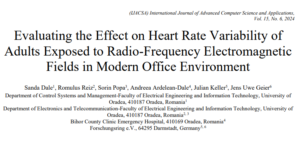Evaluating the Effect on Heart Rate Variability of Adults Exposed to Radio-Frequency Electromagnetic Fields in Modern Office Environment

Abstract: The objective of the study was to investigate whether heart rate variability (HRV) is an appropriate method to describe potential effects of RF-EMF on humans considering a modern office environment radiation level with the frequencies 1.8 GHz (DECT) and 2.45 GHz (Wi-Fi) and an exposure time of 10 min. The emitters were 1 m distant from the test subjects. The HRV parameters SDNN, RMSSD, LF and HF were recorded from 60 adults in three runs, totaling up to 154 recordings. Effects were evident for the parameter SDNN. In two runs, HRV changed from control to exposure phase, in one run from exposure phase to control. The cofactors smoking, coffee consumption, and the use of strong medications did not modulate EMF effects. HRV seems to be suitable to detect effects of radio-frequency electromagnetic fields on humans under certain conditions. In the future, prolonged exposure and new frequencies (5G) should be included in order to provide a better description of RF-EMF effects in modern office environments.
https://thesai.org/Publications/ViewPaper?Volume=15&Issue=6&Code=IJACSA&SerialNo=9

